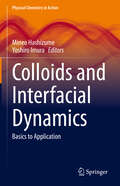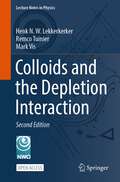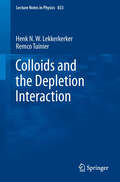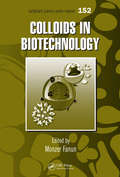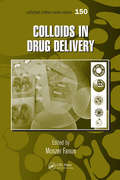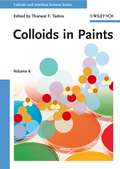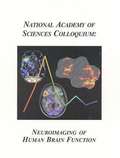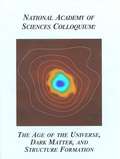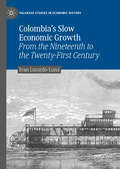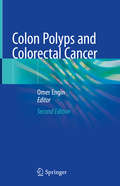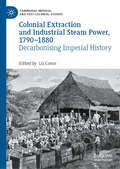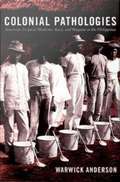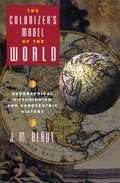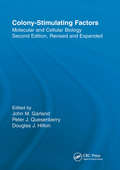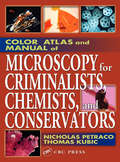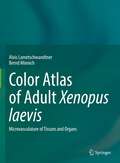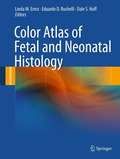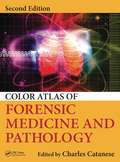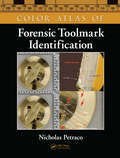- Table View
- List View
Colloids and Interfacial Dynamics: Basics to Application (Physical Chemistry in Action)
by Mineo Hashizume Yoshiro ImuraThis book presents the dynamics of colloids and interfaces in various materials such as assemblies of surfactants, lipids, nanoparticles, and surfaces of biomaterials, catalysts and engineering materials. It covers a wide range of topics, from basics to applications, on fabrication, functions, and understanding the mechanisms of those systems. The book highlights the importance of understanding from the perspective of colloidal and interfacial chemistry for the materials exhibiting dynamic behaviors. Readers can find a new direction for the development of nano-stimulus-responsive systems consisting of molecular assemblies by understanding the relationships between the dynamics of molecules, the dynamics of molecular assemblies, and the dynamics of the functions of molecular assemblies. Also, the book provides useful knowledge for the development of new photocatalysts through a detailed explanation of the complex dynamics of electron transfer on the catalyst surface. The authors hope that common denominators will be found in different materials from the perspective of the dynamics of colloids and interfaces, and that readers will find guidelines for the development of new nanomaterials.
Colloids and the Depletion Interaction (Lecture Notes in Physics #1026)
by Remco Tuinier Henk N.W. Lekkerkerker Mark VisThis open access book provides a detailed exploration of the phase behaviour of, and interfacial properties in, complex colloidal mixtures (e.g., clay, milk, blood). Insights into colloids have been at the heart of many innovations in different industries. The big question underlying these innovations is how can colloidal systems be formulated and designed towards the desired properties? To do this, the forces between the colloidal particles need to be controlled. Adding depletants (non-adsorbing polymers or small colloids) is key to controlling the attractive interactions. Colloids and the Depletion Interaction provides the qualitative insights and quantitative tools to understand and predict such forces in colloidal dispersions. It offers a concise introduction to the history and fundamentals of the depletion interaction in, and phase behaviour of, colloidal dispersions.Why does adding polymers lead to attractive forces between colloidal particles? What determines the phase stability of multi-component colloidal systems? These include colloid—polymer mixtures, binary colloidal mixtures, and anisotropic particles such as clay platelets, cubes and rod-like viruses. Conceptual explanations are accompanied by experimental and computer simulation results throughout. Illustrations of depletion effects in colloid science, biology and technology demonstrate its wider significance. The concluding outlook provides the scope of challenges and possibilities in this exciting field of science. This second updated and enlarged edition contains 12 Chapters. It is an ideal book for advanced undergraduates and graduate students in physical chemistry, chemical engineering and soft matter physics. Besides providing a fundamental understanding of depletion interactions in colloidal mixtures, it gives background information on colloidal stability and phase behaviour in general. For experienced scientists and engineers working on mixtures of colloids and non-adsorbing (bio)polymers or colloidal particles, this book serves as a reference for understanding depletion interactions in systems of their specific interest.
Colloids and the Depletion Interaction (Lecture Notes in Physics #833)
by Remco Tuinier Henk N.W. LekkerkerkerColloids are submicron particles that are ubiquitous in nature (milk, clay, blood) and industrial products (paints, drilling fluids, food). In recent decades it has become clear that adding depletants such as polymers or small colloids to colloidal dispersions allows one to tune the interactions between the colloids and in this way control the stability, structure and rheological properties of colloidal dispersions. This book offers a concise introduction to the fundamentals of depletion effects and their influence on the phase behavior of colloidal dispersions. Throughout the book, conceptual explanations are accompanied by experimental and computer simulation results.
Colloids in Biotechnology (Surfactant Science)
by Monzer FanunColloids show great potential in a wide variety of applications, including drug delivery and medical imaging, and the design and fabrication of colloid systems has attracted considerable interest in the research community. Colloids in Biotechnology describes developments in the field of biotechnological applications in the past decade and bridges t
Colloids in Drug Delivery (Surfactant Science)
by Monzer FanunColloidal drug delivery systems present a range of therapeutic benefits in the treatment of a number of challenging conditions, allowing researchers to cross barriers that have previously prevented efficient treatment while offering improved and more targeted absorption. Summarizing recent research in the field, Colloids in Drug Delivery assembles
Colloids in Paints (Colloids and Interface Science (VCH) #6)
by Tharwat F. TadrosThe first modern approach to relate fundamental research to the applied science of colloids, this series bridges academic research and practical applications, thus providing the information vital to both. Written by the very best scientists in their respective disciplines, this volume describes the role of colloids in paints, highlighting the importance of fundamental research in industrial applications. For surface, polymer and physicochemists, materials scientists, and chemical engineers.
Colloquium On Computational Biomolecular Science
by National Academy Of SciencesThe National Academies Press (NAP)--publisher for the National Academies--publishes more than 200 books a year offering the most authoritative views, definitive information, and groundbreaking recommendations on a wide range of topics in science, engineering, and health. Our books are unique in that they are authored by the nation's leading experts in every scientific field.
Colloquium On Neurobiology Of Pain
by National Academy Of SciencesThe National Academies Press (NAP)--publisher for the National Academies--publishes more than 200 books a year offering the most authoritative views, definitive information, and groundbreaking recommendations on a wide range of topics in science, engineering, and health. Our books are unique in that they are authored by the nation's leading experts in every scientific field.
Colloquium On Neuroimaging Of Human Brain Function
by Frank Rosler Charan Ranganath Brigitte Roder Rainer KluweThe National Academies Press (NAP)--publisher for the National Academies--publishes more than 200 books a year offering the most authoritative views, definitive information, and groundbreaking recommendations on a wide range of topics in science, engineering, and health. Our books are unique in that they are authored by the nation's leading experts in every scientific field.
Colloquium On The Age Of The Universe, Dark Matter, And Structure Formation
by National Academy Of SciencesThe National Academies Press (NAP)--publisher for the National Academies--publishes more than 200 books a year offering the most authoritative views, definitive information, and groundbreaking recommendations on a wide range of topics in science, engineering, and health. Our books are unique in that they are authored by the nation's leading experts in every scientific field.
Colloquium on Molecular Kinesis in Cellular Function and Plasticity
by National Academy of Sciences ColloquiumThe National Academies Press (NAP)--publisher for the National Academies--publishes more than 200 books a year offering the most authoritative views, definitive information, and groundbreaking recommendations on a wide range of topics in science, engineering, and health. Our books are unique in that they are authored by the nation's leading experts in every scientific field.
Colloquy on Minority Males in Science, Technology, Engineering, and Mathematics
by Catherine DidionOn August 8-12, 2010 the National Academy of Engineering (NAE), with funding from the National Science Foundation (NSF), convened the Colloquy on Minority Males in Science, Technology, Engineering, and Mathematics (STEM), following the release of several reports highlighting the educational challenges facing minority males. The NSF recognized the need to gather input from research communities that focus on minority males about how to frame investigations of gender-based factors that impact learning and choice in STEM education (both at the precollege and higher education levels) and the workforce for minority males. There was particular interest in framing a research agenda to study how interactions between minority males and societal and educational systems (both formal and informal) encourage or discourage the young men's interest and persistence in STEM. In addition, NSF hoped to gain community input to inform the parameters of a future NSF research program that could effectively address minority male participation in STEM. The Colloquy was held at the Mt. Washington Conference Center in Baltimore, Maryland, with approximately 40 participants, most of them researchers in education, psychology, sociology, mathematics, and physics. Colloquy on Minority Males in Science, Technology, Engineering, and Mathematics presents a summary of the Colloquy's breakout and plenary discussions, which addressed (a) research questions articulated in the breakout groups together with theories and methodologies to begin to address these questions; and (b) considerations for a potential research solicitation for the NSF, with major areas of inquiry concerning access, participation, and success for minority males in STEM. This report reflects the views of the individuals who participated in the plenary and breakout groups. It has been reviewed in draft form by persons chosen for their diverse perspectives and expertise in accordance with procedures approved by the National Academies' Report Review Committee. The purpose of this independent review is to provide candid and critical comments that will assist the institution in making its published report as sound as possible and to ensure that the report meets institutional standards for quality and objectivity.
Colo Flora: East Slope
by William A. WeberReflecting the conclusions of current taxonomic research and recognizing new species found in the state, these thoroughly updated guides offer the most complete and authoritative reference to the plants of Colorado. Both volumes explain basic terminology; discuss plant geography; and describe special botanical features of the mountain ranges, basins, and plains. Interesting anecdotes and introductions are given for each plant family, and hints on recognizing the largest families are provided as well. Each volume includes a complete glossary, indices to common and specific names, and hundreds of illustrations. Ideal both for the student and scientist, Colorado Flora: Eastern and Western Slopes, Third Edition are essential for readers interested in Colorado's plant life.
Colo Flora: West Slope
by William A. Weber Ronald C. WittmannReflecting the conclusions of current taxonomic research and recognizing new species found in the state, these thoroughly updated guides offer the most complete and authoritative reference to the plants of Colorado. Both volumes explain basic terminology; discuss plant geography; and describe special botanical features of the mountain ranges, basins, and plains. Interesting anecdotes and introductions are given for each plant family, and hints on recognizing the largest families are provided as well. Each volume includes a complete glossary, indices to common and specific names, and hundreds of illustrations. Ideal both for the student and scientist, Colorado Flora: Eastern and Western Slopes, Third Edition are essential for readers interested in Colorado's plant life.
Colombia’s Slow Economic Growth: From the Nineteenth to the Twenty-First Century (Palgrave Studies in Economic History)
by Ivan Luzardo-LunaLooking at the years 1870-2016, this book analyses the reasons behind Colombia’s chronically slow economic growth. As a comparative economic history, it examines why Colombia has seen lower growth rates than countries with similar institutions, culture and colonial origins, such as Argentina in 1870-1914, Mexico in 1930-1980, and Chile from 1982 onwards.While Colombia's history has shown relative macroeconomic stability, it has also shown a limited capacity for integrating into the world economy and embracing technological breakthroughs compared to the rest of the world, including steam, mass production and Information Technology. This volume thus moves away from the long-held view that institutional path dependence is the main determinant of differences in long-run economic growth across countries.
Colon Polyps and Colorectal Cancer
by Omer EnginThis thoroughly revised and extended second edition of the book clearly explains the nature of colon polyps and their relationship to colorectal cancer in light of new developments. It discusses in detail new topics, including polyp development, risk factors and prevention measures, and also describes surgical, medical oncology and radiotherapy treatments of colon cancer. In cases of advanced colon cancer, it clearly demonstrates how to perform surgical interventions in the presence of urinary tract metastases and gynecologic organ metastases. The book also includes chapters on medical treatment and radiotherapy in distant metastases of colorectal cancer. Further, it presents resection of liver metastases and transplantation options. Carefully examining the risk factors, and the treatment of colon cancer from the early to the advanced stages, the book is invaluable not only for medical specialists and students, but also for general readers and patients.
Colonial Extraction and Industrial Steam Power, 1790–1880: Decarbonising Imperial History (Cambridge Imperial and Post-Colonial Studies)
by Liz ConorThis book untangles the connections between British industrialization and colonial expansion in the late-eighteenth and nineteenth centuries. The addition of fossil fuels to the energy mix in this period drove overwhelming social and economic change in Britain, the north-east United States, and Europe, but it also had important and uneven consequences within a range of Euro-American colonies. Opening a new field of inquiry into fossil fuel-powered technologies and their critical role in colonial expansion, this book demonstrates how carbon- based economies dramatically accelerated the annexing of foreign lands and the extraction of their resources. Yet, while the use of coal on a commercial scale from the late 1700s powered an explosion of growth in manufacturing between 1760 and 1840 and these years coincided with the incursion and violence on colonial frontiers, the peripheries tended to rely on wood where they could. This intensification of animal and timber power complicated the nationalist narratives of coal-fired industrialization and economic development. A history of the meanings and ideas around carbon, fossil fuels, and their bearing within colonial expansion is increasingly relevant as rapid changes to climate bring into focus the legacy of carbonization in dispossession, sustainability, environmental, labor, and atmospheric relational histories.
Colonial Pathologies: American Tropical Medicine, Race, and Hygiene in the Philippines
by Warwick AndersonColonial Pathologies is a groundbreaking history of the role of science and medicine in the American colonization of the Philippines from 1898 through the 1930s. Warwick Anderson describes how American colonizers sought to maintain their own health and stamina in a foreign environment while exerting control over and "civilizing" a population of seven million people spread out over seven thousand islands. In the process, he traces a significant transformation in the thinking of colonial doctors and scientists about what was most threatening to the health of white colonists. During the late nineteenth century, they understood the tropical environment as the greatest danger, and they sought to help their fellow colonizers to acclimate. Later, as their attention shifted to the role of microbial pathogens, colonial scientists came to view the Filipino people as a contaminated race, and they launched public health initiatives to reform Filipinos' personal hygiene practices and social conduct. A vivid sense of a colonial culture characterized by an anxious and assertive white masculinity emerges from Anderson's description of American efforts to treat and discipline allegedly errant Filipinos. His narrative encompasses a colonial obsession with native excrement, a leper colony intended to transform those considered most unclean and least socialized, and the hookworm and malaria programs implemented by the Rockefeller Foundation in the 1920s and 1930s. Throughout, Anderson is attentive to the circulation of intertwined ideas about race, science, and medicine. He points to colonial public health in the Philippines as a key influence on the subsequent development of military medicine and industrial hygiene, U. S. urban health services, and racialized development regimes in other parts of the world.
Colonizer's Model of the World
by J. M. BlautThis book challenges one of the most pervasive and powerful beliefs of our time concerning world history and world geography. This is the doctrine of European diffusionism, the belief that the rise of Europe to modernity and world dominance is due to some unique European quality of race, environment, culture, mind, or spirit, and that progress for the rest of the world results from the diffusion of European civilization. J.M. Blaut persuasively argues that this doctrine is not grounded in the facts of history and geography, but in the ideology of colonialism. It is the world model which Europeans constructed to explain, justify, and assist their colonial expansion. The book first defines the Eurocentric diffusionist model of the world as one that invents a permanent world core, an "Inside," in which cultural evolution is natural and continuous, and a permanent periphery, and "Outside," in which cultural evolution is mainly an effect of the diffusion of ideas, commodities, settlers, and political control from the core. The ethnohistory of the doctrine is traced from its 16th-century origins, through its efflorescence in the period of classical colonialism, to its present form in theories of economic development, modernization, and new world order. Blaut demonstrates that most "Western" scholarship is to some extent diffusionist and based implicitly in the idea that the world has one permanent center from which culture-changing ideas tend to emanate. Eurocentric diffusionism has shaped our attitudes concerning race and the environment, psychology and society, technology and politics.
Colony-Stimulating Factors: Molecular & Cellular Biology, Second Edition,
by John M. GarlandConcentrating on proven data and adopting a structure-function approach, this text provides grounding for an intricate understanding of the molecular biology, physiological mechanisms, and routine clinical use in disease settings of colony-stimulating factors (CSFs). This edition includes eight additional chapters, with updates of recently-discovered and established CSFs, each indexed individually.
Color Atlas and Manual of Microscopy for Criminalists, Chemists, and Conservators
by Thomas Kubic Nicholas PetracoProfessionals in many disciplines, from archeology to forensic science and anthropology, must be able to identify organic and inorganic fibers and particles. In a single source, this book presents a range of simple methods to help readers quickly characterize and identify a broad range of materials.
Color Atlas of Adult Xenopus laevis: Microvasculature of Tissues and Organs
by Alois Lametschwandtner Bernd MinnichThis atlas offers stunning color electron scanning micrographs and exceptional light microscopy pictures of capillaries, vessels and diverse histomorphological tissues and organs of Xenopus laevis. The model organisms Xenopus laevis serves to study basic biological questions related to growth, differentiation, maturation, and regression of cells, tissues and organs. Xenopus and human genomes have long stretches of gene collinearity, and 79% of identified human disease genes have a verified ortholog in Xenopus. Thus, this atlas will be a powerful tool for anatomists, morphologists, histologists and physiologists interested in normal and pathologically altered organs and tissue; and to all researchers, who wish to learn more about the microvascular anatomy of this vertebrate model organism.
Color Atlas of Fetal and Neonatal Histology
by Dale S. Huff Eduardo D. Ruchelli Linda M. ErnstColor Atlas of Fetal and Neonatal Histology serves as a comprehensive atlas of the developmental histology of the major organs from 15 weeks gestation to the neonatal period. Each section includes text on basic embryologic processes that influence the development of each organ and highlight major histologic features that correspond with certain developmental periods. In addition, there are many color photomicrographs at key developmental stages to assist the reader in identifying appropriate histologic changes at each developmental stage. This book will be of great value to students of embryology, pathology residents and fellows, and attending pathologists who perform fetal autopsies.
Color Atlas of Forensic Medicine and Pathology
by Charles CataneseNow in its second edition, the best-selling Color Atlas of Forensic Medicine and Pathology is an easy-to-read reference covering forensic pathology principles, from basic to advanced concepts relating to all manners of death. Featuring over 1600 full-color images, including 400 more photographs than the first edition, this book provides unparalleled photographic illustration to enhance understanding for medical and non-medically trained personnel. Providing thorough visual demonstrations of postmortem changes of the human body, the book presents the different kinds of patterns produced in deaths resulting from Natural causes Diagnostic procedures Therapeutic procedures Substance abuse Poisoning Child abuse Firearms Blunt instruments Sharp instruments Burns Asphyxia The book also includes an entirely new section on histopathology. The text uses specific, detailed language to describe what is represented in each photo and to make side-by-side comparisons of similar but distinct pathologies. The Color Atlas of Forensic Medicine and Pathology, Second Edition is an invaluable professional reference for death investigators, medical examiners, and forensic pathologists.
Color Atlas of Forensic Toolmark Identification
by Nicholas PetracoIn the wake of the Daubert ruling, the use of forensic toolmark evidence in court has been problematic, in that the conclusions of forensic scientists as to toolmark origin often lack scientifically sound statistical proof. In the Color Atlas of Forensic Toolmark Identification, noted forensic expert Nicholas Petraco helps move toolmark examination
